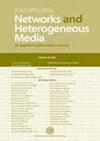Secure keys data distribution based user-storage-transit server authentication process model using mathematical post-quantum cryptography methodology
IF 1.3
4区 数学
Q3 MATHEMATICS, INTERDISCIPLINARY APPLICATIONS
引用次数: 0
Abstract
The central remote servers are essential for storing and processing data for cloud computing evaluation. However, traditional systems need to improve their ability to provide technical data security solutions. Many data security challenges and complexities await technical solutions in today's fast-growing technology. These complexities will not be resolved by combining all secure encryption techniques. Quantum computing efficiently evolves composite algorithms, allowing for natural advances in cyber security, forensics, artificial intelligence, and machine learning-based complex systems. It also demonstrates solutions to many challenging problems in cloud computing security. This study proposes a user-storage-transit-server authentication process model based on secure keys data distribution and mathematical post-quantum cryptography methodology. The post-quantum cryptography mathematical algorithm is used in this study to involve the quantum computing-based distribution of security keys. It provides security scenarios and technical options for securing data in transit, storage, user, and server modes. Post-quantum cryptography has defined and included the mathematical algorithm in generating the distributed security key and the data in transit, on-storage, and on-editing. It has involved reversible computations on many different numbers by super positioning the qubits to provide quantum services and other product-based cloud-online access used to process the end-user's artificial intelligence-based hardware service components. This study will help researchers and industry experts prepare specific scenarios for synchronizing data with medicine, finance, engineering, and banking cloud servers. The proposed methodology is implemented with single-tenant, multi-tenant, and cloud-tenant-level servers and a database server. This model is designed for four enterprises with 245 users, and it employs integration parity rules that are implemented using salting techniques. The experimental scenario considers the plain text size ranging from 24 to 8248 for analyzing secure key data distribution, key generation, encryption, and decryption time variations. The key generation and encryption time variations are 2.3233 ms to 8.7277 ms at quantum-level 1 and 0.0355 ms to 1.8491 ms at quantum-level 2. The key generation and decryption time variations are 2.1533 ms to 19.4799 ms at quantum-level 1 and 0.0525 ms to 3.3513 ms at quantum-level 2.基于安全密钥数据分发的用户存储传输服务器身份验证过程数学后量子密码学模型
中央远程服务器对于存储和处理用于云计算评估的数据至关重要。然而,传统系统需要提高其提供技术数据安全解决方案的能力。在当今快速发展的技术中,许多数据安全挑战和复杂性等待着技术解决方案。这些复杂性不能通过组合所有安全加密技术来解决。量子计算有效地发展了复合算法,使网络安全、取证、人工智能和基于机器学习的复杂系统得以自然发展。它还演示了云计算安全中许多具有挑战性问题的解决方案。本文提出了一种基于安全密钥数据分发和数学后量子密码学方法的用户-存储-传输-服务器身份验证过程模型。本研究采用后量子密码数学算法,涉及基于量子计算的安全密钥分发。它提供了在传输、存储、用户和服务器模式下保护数据的安全场景和技术选项。后量子密码学定义并包含了生成分布式安全密钥和传输、存储和编辑中的数据的数学算法。它涉及对许多不同数字的可逆计算,通过超级定位量子位来提供量子服务和其他基于产品的云在线访问,用于处理最终用户基于人工智能的硬件服务组件。这项研究将帮助研究人员和行业专家准备与医疗、金融、工程和银行云服务器同步数据的具体场景。所提出的方法是通过单租户、多租户和云租户级别的服务器以及数据库服务器实现的。该模型是为拥有245个用户的4家企业设计的,它采用了使用盐化技术实现的集成奇偶规则。实验场景考虑从24到8248的纯文本大小,用于分析安全密钥数据分发、密钥生成、加密和解密时间变化。密钥生成和加密时间变化在量子级1为2.3233 ~ 8.7277 ms,在量子级2为0.0355 ~ 1.8491 ms。密钥生成和解密时间变化在量子级1为2.1533 ms ~ 19.4799 ms,在量子级2为0.0525 ms ~ 3.3513 ms。
本文章由计算机程序翻译,如有差异,请以英文原文为准。
求助全文
约1分钟内获得全文
求助全文
来源期刊

Networks and Heterogeneous Media
数学-数学跨学科应用
CiteScore
1.80
自引率
0.00%
发文量
32
审稿时长
6-12 weeks
期刊介绍:
NHM offers a strong combination of three features: Interdisciplinary character, specific focus, and deep mathematical content. Also, the journal aims to create a link between the discrete and the continuous communities, which distinguishes it from other journals with strong PDE orientation.
NHM publishes original contributions of high quality in networks, heterogeneous media and related fields. NHM is thus devoted to research work on complex media arising in mathematical, physical, engineering, socio-economical and bio-medical problems.
 求助内容:
求助内容: 应助结果提醒方式:
应助结果提醒方式:


